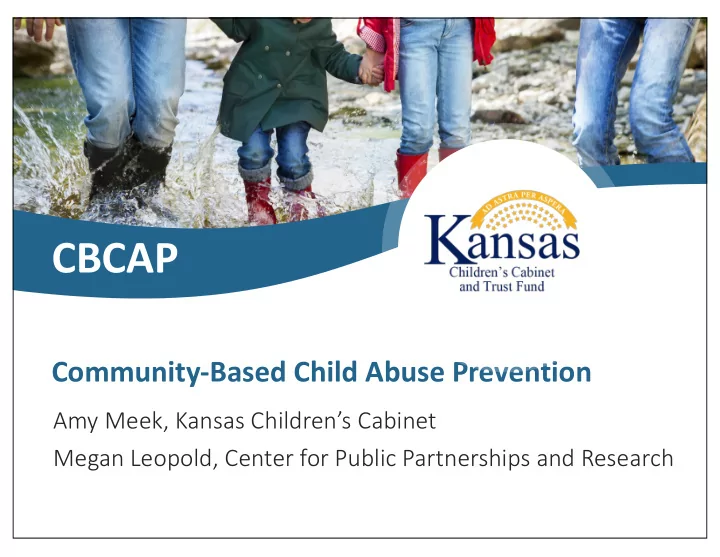

CBCAP Community-Based Child Abuse Prevention Amy Meek, Kansas Children’s Cabinet Megan Leopold, Center for Public Partnerships and Research
Established in 1996 under Title II of Child Abuse Prevention and Treatment Act FY 2018 $687,889 Federal CBCAP funds were allocated to 6 local and one statewide grantee. Cabinet contributes match dollars, and each program provides a 10% minimum match Funds initiatives that work to strengthen and support families before abuse has occurred
CBCAP is Unique A group of innovative programs designed to meet the needs of their community Complete a Prioritize Provide outreach to Create a data community needs partnerships and special populations collection plan for assessment and collaboration (fathers, families at risk participation in identify how they for homelessness, adult evaluation process will meet unmet victims of abuse and needs neglect)
A Variety of Services Programs are designed to meet the unique needs of their community
Site Visits Feb. 2019 Learn about program • challenges and successes Listen for ways we can • support programs Discuss experience with • data collection Learn about changes to • the program or services provided
Day 1 Wichita – Kansas Children’s Service League • Quality child care with licensed providers CRISIS NURSERY • Parent training and support • Connection to community providers • Connect families to child care and work with community partners to ensure a good match for family and child • Partnered with a new home-based child care provider who provides care in “off hours” to help meet this growing need The Parent Helpline launched an app for greater • STATEWIDE accessibility to families A “train the trainer” model for Trauma –informed GRANTEES • trainings will increase the availability of trainings statewide • Child Abuse Activities throughout April
Day 2 Paola and Topeka CIRCLE OF • Parent education • Parent-child interaction support SECURITY • Home visiting • Collaborating with a local homeless shelter and increasing outreach in Franklin Co • CBCAP allows connection with populations they would not typically be able to reach • Intensive case management DRUG ENDANGERED • Substance abuse treatment assistance CHILD • Home visiting • Reach new moms as early as possible by coordinating with hospital intake centers • Opportunities for families to connect , have fun, and learn • Offer a moms group focusing on infant care and development
Day 3 Pittsburg RESPONSE • Accompany police officers on calls • Offer case management and referrals ADVOCATE • Provide home visits/parent education • Drug violations and overall calls for police intervention have increased in Pittsburg • Received the Outstanding Service Award from the Pittsburg Police Department Day 4 Wyandotte HEALTHY PARENTS, P arent support groups • Adult support services • HEALTHY KIDS Fatherhood program • • Individualized outreach and on-site services to residents of 2 public housing complexes • Created a new class for Somali families to enhance knowledge of child development and build connections within the community
Day 5 Marysville • Homelessness/transitional housing FAMILY SUPPORT • Targeted case management and Home visiting PROJECT • Love and Logic classes • Pony Express Partnership is located in a campus with other community providers, increasing access to resources for families and communication between programs • E xpanding their service reach into Washington County and working to build relationships in those communities BACK IN • Followed up on questions Made changes to quarterly report based on feedback • LAWRENCE • Connected programs with supports to participate in statewide needs assessment
KEY FINDINGS Co Common Me Measu sures Ev Evaluation Kansas CBCAP is serving exceptionally vulnerable families 82% of families earn less than $20,000 a year 64% of caregivers served by CBCAP have a high school diploma or less 73% had trouble affording needs each month 46% had their food run out before they had money to buy more
KEY FINDINGS Co Common Me Measu sures Ev Evaluation Families engaged in CBCAP services are making positive changes Protective factors increased • Families showed a significant increase in the protective factors that decrease a family’s risk of child abuse and neglect Home and family environments improved • Number of families in a supportive home environment increased from • 20% at pre-test to 50% at post-test (HOME IT) • 48% at pre-test to 76% at post-test (HOME EC) Parenting behaviors increased in quality • Families assessed with KIPS showed improved scores on 100% of the 12 subscales from pre- to post-test
You have been provided a copy of the Kansas Prevention Investments Annual Report. Inside you will find: • Detailed program profiles • A description of the Common Measures Initiative and findings
Recommend
More recommend